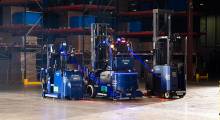If 2022 was the year when supply chain operations and e-commerce demand started to stabilize in response to the COVID-19 pandemic, 2023 will be the year when companies double down on their use of automation for predictive analytics and real-time decision making, according to Siena Analytics.
To put it more bluntly: Companies are increasingly becoming more proactive rather than reactive, and that trend will continue over the next 12 months, said the Franklin, Mass.-based company.
Siena Analytics said its customers are seeking more granular data as automation is used in more and more supply chain processes.
The company claimed that its image-recognition services allow logistics operators to “virtualize” their inventories. It does this by capturing and labeling photos of items in the warehouse and by providing digital twins and analytics powered by artificial intelligence.
Companies have learned to plan ahead
The insights provided by Siena Analytics' services have helped supply chains get the information they need to circumvent challenges and increase their resilience. That’s partly why John Dwinell, president of Siena Analytics, said he believes supply chain problems should begin to dissipate by the second and third quarter of 2023.
Companies are more prepared now and have plans in place, added Dave Green, executive chairman of Peak Technology, which acquired Siena Analytics in July.
“Let’s face it, coming out of COVID and all the supply chain [issues] the feeling was, 'Let’s survive through this,'” he said. “The feeling going into 2023 is, ‘We are going to be on plan. We’re going to do what we need to do.”
Green added: “Instead of having to react to supply chain struggles, they are able to move forward with automation plans and make those improvements they want to make instead of reacting to the challenges of the environment.”
Three or four years ago, customers saw automation as a “nice to have,” he said. Now, they are seeing robots as essential, Green noted, in part because of labor challenges.
Dwinell noted that the past two years have forced the entire supply chain industry to have more foresight.
“We’re becoming more predictable on where we are going to go and what we are going to do in the next quarter or the next six months, maybe even the next year,” he said. “In the past, we were more reactive.”
E-commerce demands still high, but not surging
Green said e-commerce orders aren’t multiplying four or five time like they were at the height of the pandemic, but they are continuing to grow at a consistent base.
Dwinell added that he believes that the market has also stabilized in the past year. While e-commerce was once driving sales, manufacturing, retail, and parcel orders are now also strong.
About the Author
Follow Robotics 24/7 on Linkedin
Article topics
Email Sign Up
















